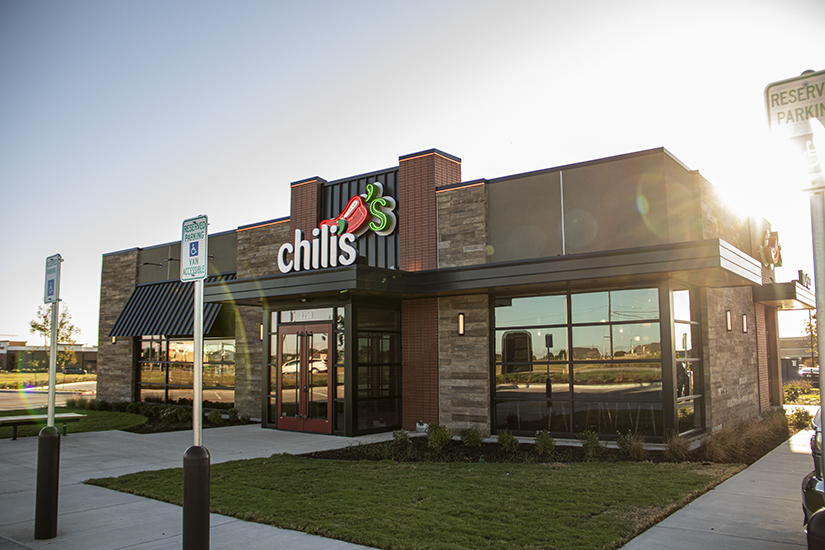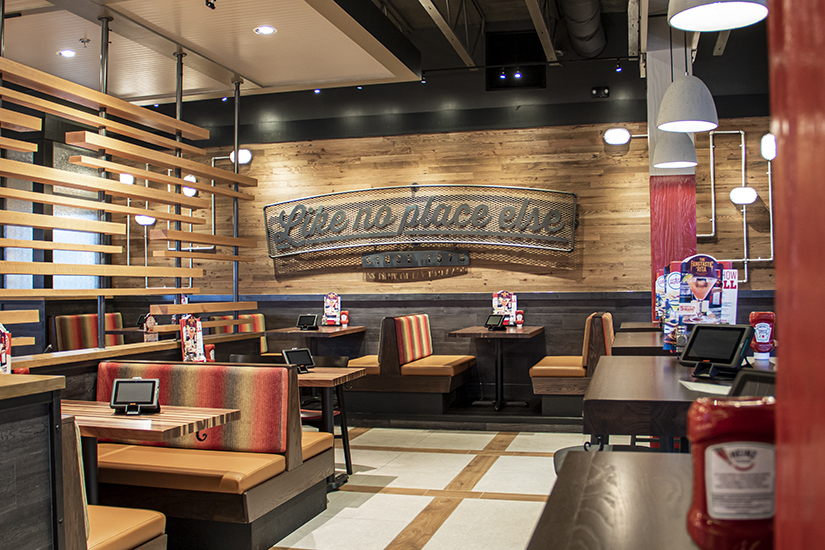|
|
While a menu is critical to a restaurant’s reception by its customers, that restaurant’s design plays an equally crucial role. Both must remain relevant, balancing trademark aspects loved by veteran visitors and evolved aesthetics to entice new diners. Even restaurants with tried-and-true branding and menus regularly update their looks.
Brinker International, the owner of the Chili’s Grill & Bar and Maggiano’s Little Italy concepts, is rolling out brand refreshes that address both aesthetic and operational needs. The effort is integral to the company’s strategic vision.
When designing renovations in the chain restaurant industry, architects must offer cost-effective plans in sync with the brand image, says Jim Fay, Brinker’s senior director of architecture and real estate. That requires a deep understanding of restaurant clientele, including cultural sensibilities and perception of the brand. Fay works closely with his counterparts in marketing to analyze the guest profile, and with his colleagues in operations to develop features to enhance service efficiency and the guest experience.

The COVID-19 pandemic upended the restaurant industry in 2020, piling on a new challenge that demanded a rapid response. Fay had to quickly devise solutions to cope with a spike in to-go and delivery orders and take measures to reduce the opportunity for disease transmission in dining areas. It was an unprecedented crisis that struck during a major renovation initiative for both Chili’s and Maggiano’s.
The pandemic’s impact on Maggiano’s was particularly disruptive. The family-driven, Italian-themed restaurant counts on large events and parties for a significant share of revenue. The pandemic shut all that business down, and a for a time the only option was a to-go model for both brands.
Brinker responded by launching It’s Just Wings, a virtual chicken wing brand for the pickup and delivery market. The orders are prepared within existing restaurants and delivered by DoorDash. Brinker also expanded Maggiano’s Italian Classics, a virtual brand consisting of a reduced menu from the brick-and-mortar establishment. Both Maggiano’s and Chili’s prepare orders in-store.
“Even before COVID, both restaurants were underutilized,” Fay admits. Each had the capacity in physical space and labor to increase its kitchen output. To take advantage of the growing to-go opportunity, though, Fay had to react quickly—primarily by redesigning the back of the house area where orders are compiled, checked for accuracy, and packed for delivery.

The new arrangement added five levels of wall shelving to hold condiments, to-go packaging, and bags. In addition, both brands replaced the printers that outputted the contents of specific orders with new ones that accommodated paper backed with adhesive so receipts can easily be affixed to orders.
In addition, both Chili’s and Maggiano’s dedicated additional parking spaces for delivery drivers and for curbside pickup by customers. These adjustments made both brands more adaptive to COVID and its aftermath.
“It was like creating ghost kitchens almost overnight,” Fay remarks. The senior director also sourced clear acrylic screens and mounting hardware from a vendor near Brinker’s Dallas headquarters and was able to get them installed between booths, adding a protective layer to reduce the potential spread of viruses at locations nationwide. “This allowed us to immediately move to 50, then 75 percent occupancy when restrictions eased,” he says.

In recent months, Fay has focused his attention on refreshing the physical space of both brands. For Maggiano’s, the intent is to update the look and feel while continuing to echo the vibe of 1940s Little Italy. “The idea is to step into the future while holding hands with the past,” he explains. The delicate balance is being executed primarily through new finishes and lighting. The emphasis, he describes, is on the banquet rooms—a key part of the business.
“We want to make them more versatile and conducive to hosting a wide variety of events such as bar mitzvahs, weddings, graduations, and family celebrations,” Fay says. He is incorporating a more neutral, gray-toned color palette and swapping outdated crystal chandeliers with more contemporary fixtures that will project a cooler, clearer light temperature.
More subtle touches will also help transform the ambience. Wall art in the current design includes period black-and-white photos of gatherings around large spreads of Italian food. The new design will add recent photos of guests celebrating at Maggiano’s gleaned from Instagram posts. In addition, modern musical artists will be incorporated into the big band audio mix—think Lady Gaga duets with Tony Bennet and other contemporary musicians paying tribute to both classic and contemporary American songs.

Chili’s redesign will also feature a toned-down color palette. Today, its exteriors are bright and multicolored. The new look will feature muted colors and black awnings replacing the current red, green, and white window adornments. Inside, the most noticeable change at Chili’s will be a total reconstruction of the bar, transforming a shotgun-style feature into a more expansive island form. This will be accompanied by the removal of the back area of the bar to bring in natural light, making the area much lighter.
The renovation plans for both brands are ambitious, multiyear projects. Fay says executing them well depends on two factors: assembling top-notch project teams and being flexible about sourcing materials. Design consultants, contractors, and suppliers must be well coordinated and focused on value engineering to get the best value for the projected $250,000 budget for each location.
That is particularly critical in the current environment where materials shortages are common. “Costs are going up every quarter,” Fay says. “You need to be prepared to choose alternates if you can’t source the product you want.”
Indeed, agility is more imperative than ever in the design and construction industry. And that’s especially critical in a fast-paced industry like food service—pandemic or no pandemic.


